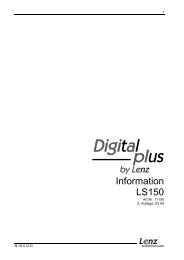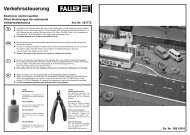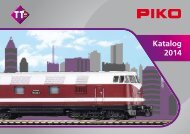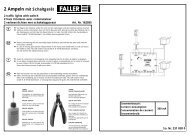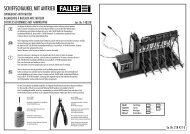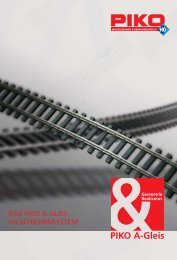INSTRUCTION MANUAL
INSTRUCTION MANUAL
INSTRUCTION MANUAL
Create successful ePaper yourself
Turn your PDF publications into a flip-book with our unique Google optimized e-Paper software.
Decoder MX620 - MX622, MX630 - MX632 Sound Decoder MX640 - MX648 Page 43<br />
CV Designation Range<br />
INCstep<br />
Default<br />
Description<br />
CV Designation Range<br />
INCstep<br />
Default<br />
Description<br />
LEAD<br />
- CV<br />
#284<br />
Threshold for<br />
deceleration sound<br />
0 -255<br />
(internal<br />
speed<br />
steps)<br />
1 1<br />
with each speed increase, even if it’s just 1 step.<br />
Steam chuffs should be played back at less volume<br />
(or no sound at all) signifying the reduced<br />
power requirement during deceleration. The<br />
sound reduction logic is analog to a reversed<br />
acceleration (per CV #281 to #283).<br />
= 1: Reduces sound to minimum (as per CV<br />
#286) when speed is reduced by just 1 step.<br />
= 2, 3 ... sound reduced to minimum after<br />
lowering speed by this number of steps.<br />
#291<br />
From SW-version 20<br />
Thyristor control<br />
Sound pitch at maximum<br />
speed<br />
for<br />
ELECTRIC engines<br />
From SW-version 20<br />
0 - 100 10 100<br />
= 1- 99: corresponding change in pitch<br />
= 100: pitch doubles already at “medium speed”.<br />
Percentage of the thyristor pitch increase at maximum<br />
speed compared to standstill.<br />
= 0: no change, pitch remains the same as at<br />
standstill.<br />
= 1- 99: corresponding change in pitch<br />
= 100: pitch doubles at “maximum speed”.<br />
#285<br />
#286<br />
LEAD<br />
- CV<br />
#287<br />
Duration of reduced<br />
volume during<br />
deceleration<br />
Volume level during<br />
deceleration<br />
Brake squeal<br />
threshold<br />
#288 Minimum driving time<br />
before brake squeal<br />
#289<br />
LEAD<br />
- CV<br />
#290<br />
Thyristor control<br />
Sound pitch for<br />
stepping effect of<br />
ELECTRIC engines<br />
From SW version 20<br />
Thyristor control<br />
Sound pitch at<br />
medium speed<br />
for<br />
ELECTRIC engines<br />
0 - 255<br />
=<br />
0 - 25 sec<br />
10<br />
30<br />
=<br />
3 sec<br />
0 - 255 10 20<br />
0 – 255<br />
(internal<br />
speed<br />
steps)<br />
0 - 255<br />
=<br />
0 - 25 sec<br />
10 20<br />
10 50<br />
1 - 255 10 1<br />
0 - 100 10 40<br />
After the speed has been reduced, the sound<br />
should remain quieter for a specific time (analog<br />
to the acceleration case).<br />
Value in CV #285 = time in tenth of a second!<br />
CV #286 is used to define the chuff volume during<br />
deceleration (Default: 20 = pretty quiet but not<br />
muted).<br />
If CV #284 = 1 (deceleration threshold set to 1<br />
speed step), the volume defined here is applied<br />
with every reduction in speed (even if decreased<br />
by just 1 step).<br />
The brake squeal should start when the speed<br />
drops below a specific speed step. It will be automatically<br />
stopped at speed 0 (based on back-EMF<br />
results).<br />
The brake squeal is to be suppressed when an<br />
engine is driven for a short time only, which is<br />
usually a shunting run and often without any cars<br />
(in reality it is mostly the cars that are squealing<br />
not the engine itself!).<br />
Note: Brake squeal sounds can also be assigned<br />
to a function key (see allocation procedure CV<br />
#300 = …), with which they can be played manually<br />
or stopped!<br />
The pitch of the thyristor control sound of many<br />
engines (typical example: Taurus) should not ascend<br />
evenly but rather in steps (scale).<br />
= 1: no stepping effect, even ascend<br />
1 - 255: ascending scale according to the corresponding<br />
speed step interval.<br />
Percentage of the thyristor pitch increase at medium<br />
speed compared to standstill. Define the “medium<br />
speed” in CV #292.<br />
= 0: no change, pitch remains the same as at<br />
standstill.<br />
#292<br />
LEAD<br />
- CV<br />
#293<br />
#294<br />
#295<br />
LEAD<br />
- CV<br />
#296<br />
#297<br />
Thyristor control<br />
Speed step for<br />
medium speed<br />
for<br />
ELECTRIC engines<br />
Thyristor control<br />
Volume at steady<br />
speed<br />
for<br />
ELECTRIC engines<br />
Thyristor control<br />
Volume during<br />
acceleration<br />
for<br />
ELECTRIC engines<br />
Thyristor control<br />
Volume during<br />
deceleration<br />
Motor sound of<br />
ELECTRIC engines<br />
Peak motor sound<br />
volume<br />
for<br />
ELECTRIC engines<br />
Motor sound,<br />
when sound<br />
becomes audible for<br />
ELECTRIC engines<br />
#298 Motor sound,<br />
starting point of<br />
0 - 255 10 100<br />
0 - 255 10 30<br />
0 - 255 10 100<br />
0 - 255 10 50<br />
0 -255 10 100<br />
0 -255 10 30<br />
0 -255<br />
10 128<br />
(> CV# 297)<br />
Internal speed step defined as “medium speed”<br />
for the pitch level according to CV #290.<br />
The CV’s #290 – 292 form a three-point characteristic<br />
curve for the pitch of the thyristor control<br />
sound, starting at standstill, where the original<br />
sample is always played back.<br />
Thyristor control-sound volume at steady speed<br />
(no acceleration or deceleration in process).<br />
Note: load dependency is set with CV’s #277 and<br />
up but is not yet possible with SW-Version 4.<br />
Volume during heavier accelerations; the value in<br />
CV #294 should be larger than in CV #293 to be<br />
useful (so that the volume increases when the engine<br />
accelerates).<br />
A lower volume is automatically selected at lesser<br />
accelerations (exact algorithm is not finalized with<br />
SW-Version 4).<br />
Volume during heavier decelerations (braking);<br />
the value in CV #295 may be higher or lower than<br />
in CV #293, depending on whether the thyristors<br />
are stressed during power feedback to the net<br />
(which increases the volume) or not (which decreases<br />
the volume).<br />
Maximum volume of motor sound at full speed or<br />
at the speed defined by CV #298.<br />
Internal speed step at which the motor sound becomes<br />
audible; the sound starts quietly at this<br />
speed and reaches the maximum volume as per<br />
CV #296 at the speed defined in CV #298.<br />
Internal speed step at which the motor sound<br />
reaches full volume; at this speed step the motor




